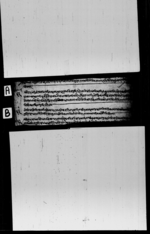A copy of a lālamohara granting Raṅganātha Pauḍyāla land in Hetauda [VS 1863]
ID: K_0096_0007A
Edited and
translated by Simon Cubelic
in collaboration with
Rajan Khatiwoda
Created: 2019-03-08;
Last modified: 2019-05-13
For the metadata of the document, click here
The accompanying edition, translation/synopsis and/or commentary are available under the terms of the Creative Commons Attribution-ShareAlike 4.0 International License
Abstract
This document is a shortened copy of a lālamohara from 1806 CE in which a land grant to Raṅganātha Pauḍyāla in Hetauda on the occasion of Meṣasaṃkrānti is recorded and the location of this land is specified.Diplomatic edition
[1r]
1६३1श्रीगुरुपंडितरंगनाथपंडितज्यूलाइ१८६३सालचैत्रशुदि३रोज७मेषसंक्रांतिकादिनकुसपानिडल्लोसंकल्प[...][...]2डाकाअम्वलमापूर्वहेटौडावाटनेपालआउन्यावाटोदक्षिणमाझिलोढिकपश्चिमरापतिषोलोउ[...][...]
3सेनथानकोषोल्सिदेषिरापतिषोलाघाटजान्यावाटोयेतिचारकिलाभित्रकोजगाविर्त्तावितलपग[...]
4मितिआश्विनशुदि७रोजम् ¯ ¯ ¯ ¯ ¯ ¯
Translation
[1r]
631
On Saturday, the 3rd of the bright fortnight of Caitra in the [Vikrama] era year 1863—the day of the vernal equinox (meṣasaṃkrānti)2 —we granted land in the territory of Hetauda as a birtābitalapa to Venerable Guru Paṇḍita Raṅganātha Paṇḍitajyū after kuśa and water [were brought] and a ritual declaration (saṃkalpa) to a clod of earth (dallo)3 was made. [The land] has the [following] four border markers: east, the track leading to Nepāla; south, the middle knoll; west, the river Rāpati; north, the rivulet at the Bhīmasenathāna up to the Rāpati ghat. The 7th of the bright fortnight of Āśvina. 4
Commentary
The present document does not specify who authorized the grant to Raṅganātha Paṇḍita, whose full name was Raṅganātha Pauḍyāla (e.g. Pauḍela VS 2072). As it is the copy of a lālamohara, one can assume that it was issued by King Gīrvāṇayuddha Vikrama Śāha (r. 1799–1816). The land grant recorded in this document is dated 1806 CE, two years after Raṅganātha returned from his exile in Benares and became a rājaguru at the Nepalese court, and only a few weeks before the assassination of Raṇabahādura. Several characteristic elements of a lālamohara including the invocatio, intitulatio, sanctio and subscriptiones have been left out of the copy. In comparison with similar land grant deeds, such as DNA_0013_0077, the impression is that even sentences of the main body of the original may have been shortened and parts of the description of the ritual process omitted. Therefore, one suspects that the document has excerpted parts rather than being a proper copy of the lālamohara, reducing the deed to its bare essentials for purposes of recordkeeping. Somewhat unusual, too, is the fact that the exact size of the gifted land is not recorded. It remains unclear whether this is a result of the copying or was already in the original so. M. C. Regmi reports about a type of birtā grant called sasīma birtā in which only the boundaries and not the area enclosed were specified (Regmi 1964: 170), and it seems that such grants were in use until the end of the 19th century (Regmi 1964: 62). The microfilm image of this document contains in the upper and lower margins fragments of other documents copied onto a single roll of paper. These fragments have not been included in either the present edition or translation.

